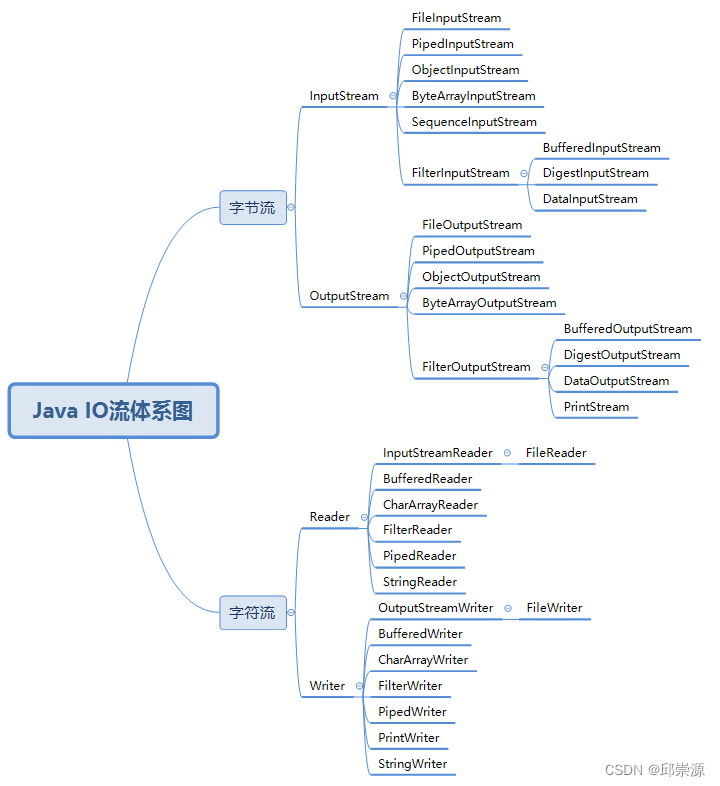
Java知识点--IO流(上)
一、文件
1、文件的含义
文件是保存数据的地方,比如word文档,txt文本文件,视频,图片等都是文件。
2、文件流
文件在程序中是以流的形式来操作的。 输入流:数据从文件到程序(内存)的路径。(在程序中读取文件数据)
输入流:数据从文件到程序(内存)的路径。(在程序中读取文件数据)
输出流:数据从程序(内存)到文件的路径。(在程序中将数据写入文件)
二、常用的文件操作
1、创建文件对象相关构造器和方法
相关构造器:
new File(String filePath) 根据路径创建File对象
new File(File parent,String child) 根据父目录文件+子路径创建File对象
new File(tring parent,String child) 根据父目录+子路径创建File对象
方法:
createNewFile 创建新文件
2、创建文件案例演示(三种创建方法)
import org.junit.jupiter.api.Test;import java.io.File;import java.io.IOException;publicclassFileCreate{publicstaticvoidmain(String[] args){}
@Test
publicvoidcreate01(){
String filePath ="e:\\news1.txt";
File file =newFile(filePath);try{
file.createNewFile();
System.out.println("文件创建成功");}catch(IOException e){
e.printStackTrace();}}
@Test
publicvoidcreate02(){
File parentFile =newFile("e:\\");
String fileName ="news2.txt";
File file =newFile(parentFile, fileName);try{
file.createNewFile();
System.out.println("文件创建成功");}catch(IOException e){
e.printStackTrace();}}
@Test
publicvoidcreate03(){
String parentPath ="e:\\";
String fileName ="news3.txt";
File file =newFile(parentPath, fileName);try{
file.createNewFile();
System.out.println("文件创建成功");}catch(IOException e){
e.printStackTrace();}}}
3、获取文件相关信息的方法
“文件名字” — getName()
“文件绝对路径” — getAbsolutePath()
“文件父级目录” — getParent()
“文件大小(字节)” — length()
“文件是否存在” — exists()
“是不是一个文件” — isFile()
“是不是一个目录” — isDirectory()
4、获取文件相关信息方法案例演示
import org.junit.jupiter.api.Test;import java.io.File;publicclassFileInformation{publicstaticvoidmain(String[] args){}
@Test
publicvoidinfo(){
File file =newFile("e:\\news1.txt");
System.out.println("文件名字"+ file.getName());
System.out.println("文件绝对路径"+ file.getAbsolutePath());
System.out.println("文件父级目录"+ file.getParent());
System.out.println("文件大小(字节)"+ file.length());
System.out.println("文件是否存在"+ file.exists());
System.out.println("是不是一个文件"+ file.isFile());
System.out.println("是不是一个目录"+ file.isDirectory());}}
5、目录的操作与删除
mkdir():创建一级目录
mkdirs():创建多级目录
delete():删除目录或文件
6、应用案例演示
(1)判断e:\news1.txt是否存在,如果存在就删除
(2)判断d:\demo02是否存在,如果存在就删除,否则提示不存在
(3)判断d:\demo\a\b\c是否存在,如果存在就提示存在,否则创建
import org.junit.jupiter.api.Test;import java.io.File;publicclassDirectory_{publicstaticvoidmain(String[] args){}
@Test
publicvoidm1(){
String pathName ="e:\\news1.txt";
File file =newFile(pathName);if(file.exists()){if(file.delete()){
System.out.println("删除成功");}else{
System.out.println("删除失败");}}else{
System.out.println("该文件不存在");}}
@Test
publicvoidm2(){
String pathName ="d:\\demo02";
File file =newFile(pathName);if(file.exists()){if(file.delete()){
System.out.println("删除成功");}else{
System.out.println("删除失败");}}else{
System.out.println("该目录不存在");}}
@Test
publicvoidm3(){
String directoryPath ="d:\\demo\\a\\b\\c";
File file =newFile(directoryPath);if(file.exists()){
System.out.println(directoryPath +"已经存在");}else{if(file.mkdirs()){
System.out.println(directoryPath +"创建成功");}else{
System.out.println(directoryPath +"创建失败");}}}}
三、IO 流原理及流的分类
1、Java IO 流原理
(1) I/O是Input/Output的缩写,l/O技术是非常实用的技术,用于处理数据传输。如读/写文件,网络通讯等。
(2) Java程序中,对于数据的输入/输出操作以”流(stream)”的方式进行。
(3) java.io包下提供了各种“流”类和接口,用以获取不同种类的数据,并通过方法输入或输出数据。
(4) 输入input:读取外部数据(磁盘、光盘等存储设备的数据)到程序(内存)中。
(5) 输出output:将程序(内存)数据输出到磁盘、光盘等存储设备中。
2、流的分类
按操作数据单位不同分为:字节流(8 bit)二进制文件,字符流(按字符)文本文件
按数据流的流向不同分为:输入流,输出流
按流的角色的不同分为:节点流,处理流/包装流
(抽象基类)字节流字符流输入流InputStreamReader输出流OutputStreamWriter
1) Java的IO流共涉及40多个类,实际上非常规则,都是从如上4个抽象基类派生的。
2)由这四个类派生出来的子类名称都是以其父类名作为子类名后缀。
四、IO 流体系图

五、FileInputStream 字节输入流
可以用单个字节来读取文件,也可以用字节数组来读取文件。
以字节数组为例:
1、确定文件路径
String filePath = “e:\hello.txt”;
2、引入FileInputStream
FileInputStream fileInputStream = new FileInputStream(filePath);
3、定义字节数组
byte[] buf = new byte[8];
4、定义读取字节数
int data = 0;
5、读取数据
while((data = fileInputStream.read(buf))!=-1){
System.out.println(newString(buf,0, data));}
用while循环读取,条件 = -1时说明读取完毕
6、关闭流
fileInputStream.close();
7、完整版
publicvoidreadFile02(){
String filePath ="e:\\hello.txt";
FileInputStream fileInputStream =null;
byte[] buf =newbyte[8];
int data =0;try{
fileInputStream =newFileInputStream(filePath);while((data = fileInputStream.read(buf))!=-1){
System.out.println(newString(buf,0, data));}}catch(IOException e){
e.printStackTrace();}finally{try{
fileInputStream.close();}catch(IOException e){
e.printStackTrace();}}}
六、FileOutputStream 字节输出流
可以用单个字节来写入文件,也可以用字节数组来写入文件。
以字节数组为例:
1、确定文件路径
String filePath = “e:\a.txt”;
2、引入FileOutputStream
FileOutputStream fileOutputStream = new FileOutputStream(filePath);//运行时会覆盖上一次的结果
FileOutputStream fileOutputStream = new FileOutputStream(filePath, true); //运行时不会覆盖上一次的结果
3、写入数据
String str = “hello,world!”;
fileOutputStream.write(str.getBytes());
4、关闭流
fileOutputStream.close();
5、完整版
publicvoidwriteFile(){
String filePath ="e:\\a.txt";
FileOutputStream fileOutputStream =null;try{//运行时会覆盖上一次的结果
fileOutputStream =newFileOutputStream(filePath);//运行时不会覆盖上一次的结果
fileOutputStream =newFileOutputStream(filePath,true);//写入单个字符
fileOutputStream.write('H');//写入字符串
String str ="hello,world!";//将字符串转成字节数组
fileOutputStream.write(str.getBytes());//控制写入字符串范围
fileOutputStream.write(str.getBytes(),0, str.length());}catch(IOException e){
e.printStackTrace();}finally{try{
fileOutputStream.close();}catch(IOException e){
e.printStackTrace();}}}
七、用字节流拷贝文件
1、确定原文件与新文件路径
String filePath = “e:\1.jpg”;
String newFilePath = “d:\1.jpg”;
2、引入FileInputStream 与 FileOutputStream
FileInputStream fileInputStream = new FileInputStream(filePath);
fileOutputStream fileOutputStream = new FileOutputStream(newFilePath);
3、定义字节数组
byte[] buf = new byte[1024];
4、定义读取字节数
int data = 0;
5、拷贝数据
while((data = fileInputStream.read(buf))!=-1){
fileOutputStream.write(buf,0, data);}
6、关闭流
fileInputStream.close();
fileOutputStream.close();
7、完整版
import java.io.FileInputStream;import java.io.FileOutputStream;import java.io.IOException;publicclassFileCopy{publicstaticvoidmain(String[] args){
String filePath ="e:\\1.jpg";
String newFilePath ="d:\\1.jpg";
FileInputStream fileInputStream =null;
FileOutputStream fileOutputStream =null;try{
fileInputStream =newFileInputStream(filePath);
fileOutputStream =newFileOutputStream(newFilePath);
byte[] buf =newbyte[1024];
int data =0;while((data = fileInputStream.read(buf))!=-1){
fileOutputStream.write(buf,0, data);}
System.out.println("拷贝成功");}catch(IOException e){
e.printStackTrace();}finally{try{if(fileInputStream !=null){
fileInputStream.close();}if(fileOutputStream !=null){
fileOutputStream.close();}}catch(IOException e){
e.printStackTrace();}}}}
八、FileReader 字符输入流
可以用单个字符来读取文件,也可以用字符数组来读取文件。
1、FileReader 相关方法:
(1) new FileReader(File/String)
(2) read:每次读取单个字符,返回该字符,如果到文件末尾返回-1
(3) read(char[]):批量读取多个字符到数组,返回读取到的字符数,如果到文件末尾返回-1
相关API:
(1) new String(char[]):将char[]转换成String
(2) new String(char[],off,len):将char[]的指定部分转换成String
2、以字符数组来读取文件
import java.io.FileReader;import java.io.IOException;publicclassFileReader_{publicstaticvoidmain(String[] args){
String filePath ="e:\\story.txt";
FileReader fileReader =null;
char[] chars =newchar[100];
int data =0;try{
fileReader =newFileReader(filePath);while((data = fileReader.read(chars))!=-1){
System.out.print(newString(chars,0, data));}}catch(IOException e){
e.printStackTrace();}finally{try{
fileReader.close();}catch(IOException e){
e.printStackTrace();}}}}
九、FileWriter 字符输入流
1、 FileWriter 常用方法
1) new FileWriter(File/String):覆盖模式,相当于流的指针在首端
2) new FileWriter(File/String,true):追加模式,相当于流的指针在尾端
3) write(int):写入单个字符
4) write(char[]):写入指定数组
5) write(char[],off,len):写入指定数组的指定部分
6) write(string):写入整个字符串
7) write(string,off,len):写入字符串的指定部分
相关API: String类: toCharArray:将String转换成char[]
>注意:
FileWriter使用后,必须要关闭(close)或刷新(flush),否则写入不到指定的文件!
2、写入文件案例
import java.io.FileWriter;import java.io.IOException;publicclassFileWriter_{publicstaticvoidmain(String[] args){
String filePath ="e:\\1.txt";
FileWriter fileWriter =null;try{
fileWriter =newFileWriter(filePath);
fileWriter.write('H');
char[] chars ={'a','b','c'};
fileWriter.write(chars);
fileWriter.write("大事发生".toCharArray(),0,2);
fileWriter.write("巅峰时代");
fileWriter.write("法国电视",0,3);}catch(IOException e){
e.printStackTrace();}finally{try{
fileWriter.close();}catch(IOException e){
e.printStackTrace();}}}}
版权归原作者 邱崇源 所有, 如有侵权,请联系我们删除。